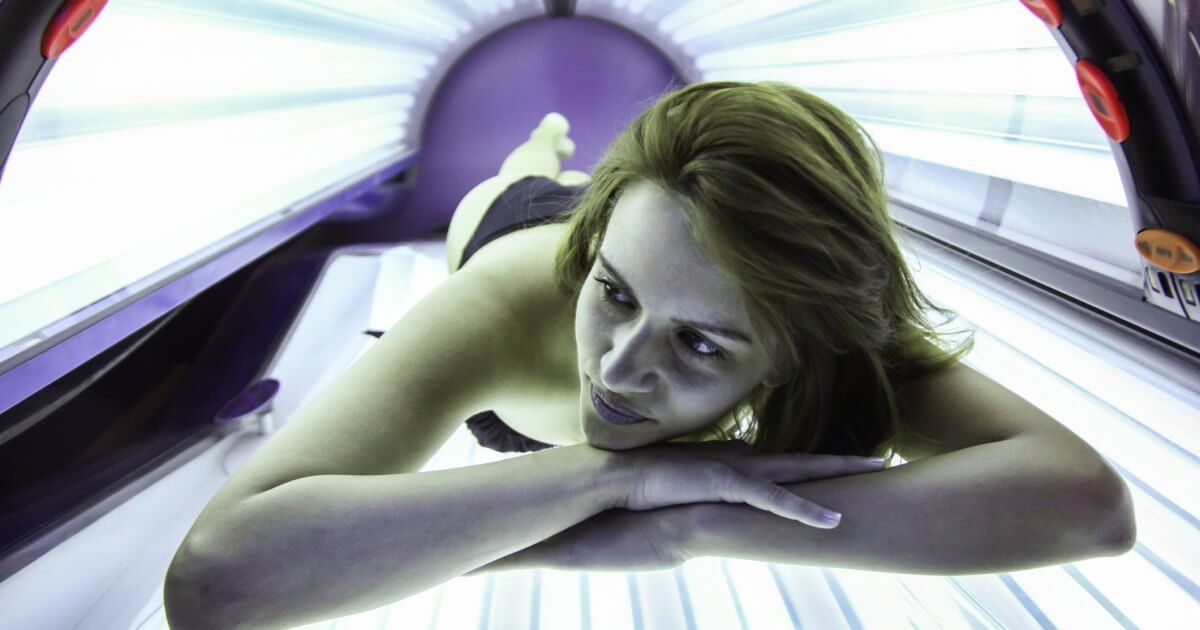The Dangers of Tanning
- In a TikTok that’s been viewed over 829,000 times, 20-year-old Harriet Hart shared a video of her inside a tanning bed. Commenters were quick to reply with their valid concern for the young girl and share their thoughts about tanning beds and skin cancer risk.
- Tanning beds are dangerous because they expose you to the same harmful UVA/UVB rays you get from the sun, but in the bed these rays reach you from only 6-8 inches away. Studies have shown that exposure to tanning beds increases the risk of skin cancer and ocular cancer.
- Just one indoor tanning session can increase the risk of melanoma by 20 percent, squamous cell carcinoma by 67 percent and basal cell carcinoma by 29 percent, according to the American Academy of Dermatology.
- One of our experts says “spray tans and sunless tanning lotions are safe” if you’re seeking an alternative to tanning beds.
Time and time again, we’ve seen people on social media glamorizing unsafe practices to get that ‘perfect glow.’ But a lot of times, users don’t know the serious damage they are doing to their skin.
Read MoreBut viewers were quick to comment on the video and share their concern. One user wrote, “The skin damage tho,” to which the original poster replied with “Freckles x.”@harrietharttTell me wrong♬ Originalton – miirk4n
Another user said, “People often mistake the sun damage as freckles. Please be careful girl.” Another comment reads, “Used to do this too. Just had melanoma cut off my leg.”
SurvivorNet wants to emphasize that any amount of tanning increases your skin cancer risk. And tanning beds, in particular, pose a very serious health risk.
The Dangers of Tanning Beds
Tanning beds should always be avoided to reduce your risk of developing skin cancer. Just one indoor tanning session can increase the risk of melanoma by 20 percent, squamous cell carcinoma by 67 percent and basal cell carcinoma by 29 percent, according to the American Academy of Dermatology.
Examining Your Skin for Melanoma: Remember ABCDE
When you hop into a bed, you are exposing yourself to the very same dangerous rays you expose yourself to outside but they're only 6-8 inches away. And in a study published in Cancer, a peer-reviewed journal of the American Cancer Society, researchers suggest that banning tanning beds among minors would prevent thousands of cases of melanoma in adolescents, along with millions of dollars in healthcare costs.
So, even if the temptation of achieving a nice "glow" seems irresistible, you should note that health experts warn against using them.
"Studies have shown that exposure to tanning beds increases the risk of skin cancer and ocular cancer," says Dr. Lynn A. Cornelius, chief of the division of dermatology at Washington University School of Medicine in St. Louis. "It also induces changes that lead to premature aging of the skin. There is no 'safe' tanning bed."
Dr. Pavlick echoed Dr. Cornelius' statements by explaining that tanning beds increase your chances of melanoma "exponentially."
Tanning Salons Pose a Big Risk for Skin Cancer
"We know there is a direct correlation with [melanoma] patients who go to indoor tanning salons," Dr. Pavlick tells SurvivorNet, who notes that the exposure "is about 6 inches from your body."
The sun is millions of miles away when you're on a beach, "so you have to think of the intensity that you're exposing your skin to when you go to a tanning salon," she says.
Alternatives to the UV-Blasting Beds
If achieving the perfect tan is very important to you, there are other options to try instead of the UV-blasting beds or prolonged sun exposure. Temporary options like spray tans and self-tanning lotions are thought to be far better alternatives.
Top 5 Ways to Protect Your Skin From Skin Cancer
"Spray tans and sunless tanning lotions are safe," Dr. Cornelius says. "One should take precautions not to inhale the product when getting a spray tan. Skin allergic reactions are rare."
Spray tans are a much safer alternative to the beds, but Dr. Craig Elmets, professor in the Department of Dermatology at the University of Alabama at Birmingham School of Medicine, says that not much is known about the side effects of spray tans.
"They even have a very mild sunscreen effect," he says, adding that applying sunblock is still recommended when going outdoors. "Not a lot is known about the side effects, but there is very limited absorption and they have been available for decades without any reports of serious side effects, which is reassuring."
Self-tanning pills are another option for people seeking a golden glow, but tanning pills are not FDA-approved or endorsed by dermatologists. Dr. Elmets notes that they have also been associated with allergic reactions and systemic side effects.
Learn more about SurvivorNet's rigorous medical review process.


